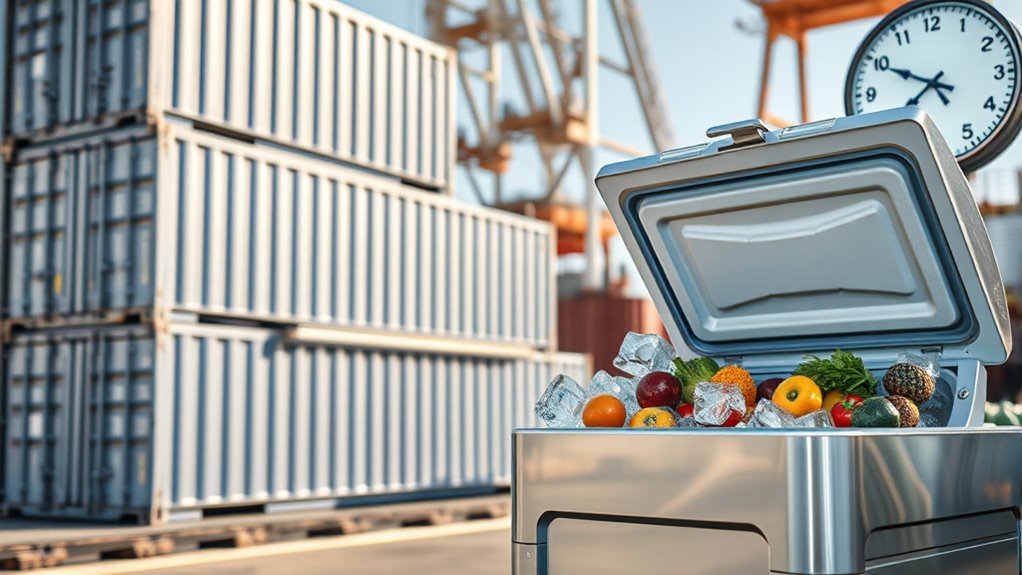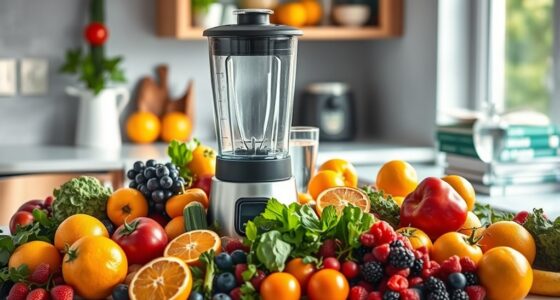To optimize your cleanse logistics, choose durable, airtight reusable containers made from eco-friendly materials to keep food fresh and organized. Use insulated coolers with quality insulation to maintain safe temperatures during transport, ensuring perishables stay below 40°F. Manage timing carefully by transferring items from the fridge to coolers as needed and labeling containers with dates. Staying on top of these steps helps prevent contamination and spoilage—keep going to explore more tips and tricks.
Key Takeaways
- Use durable, airtight reusable containers to maintain food freshness and prevent contamination during storage and transport.
- Choose insulated coolers with high-quality materials for consistent temperature control over extended periods.
- Plan and schedule food transfers from fridge to cooler to minimize room temperature exposure, ideally under 2 hours.
- Label containers with dates to monitor storage duration and ensure food safety.
- Combine containers with cooling equipment and organize packing to reduce temperature fluctuations and optimize logistics.

When it comes to keeping food fresh and safe, choosing the right containers and coolers, along with precise timing, makes all the difference. Proper storage begins with selecting containers made from reusable materials that are durable, eco-friendly, and designed to maintain ideal conditions. Reusable containers not only reduce waste but also often feature better insulation qualities, which help with temperature control. When you opt for containers that are built to last and designed for repeated use, you’re guaranteeing that your food stays fresh longer and that you’re making a sustainable choice. These containers are typically airtight, preventing leaks and contamination, and they fit well into your overall cooling strategy.
Temperature control plays a fundamental role in preserving the quality of your food. When you use the right containers, you help maintain a consistent temperature, which is essential for slowing bacterial growth and preventing spoilage. For perishable items like dairy, meats, and cooked foods, keeping them at the right temperature—usually below 40°F (4°C)—is indispensable. Reusable containers with good insulation capabilities can help you achieve this, especially when combined with proper cooling equipment. You might also consider using insulated coolers that are designed with high-quality materials to keep temperatures stable over extended periods. These coolers are especially useful when you’re transporting food or need to store items for a longer duration, ensuring they stay at safe temperatures without frequent fridge trips.
Timing is equally important in the storage process. You should plan your food logistics carefully, knowing when to transfer items from the fridge to the cooler and how long they can stay within safe temperature ranges. For example, perishable foods should not be left out at room temperature for more than two hours, or one hour if the temperature exceeds 90°F (32°C). Using reusable containers and coolers helps streamline this process because you can pre-pack and organize foods for quick access, reducing the risk of temperature fluctuations. When you pack food into containers, label them with dates, so you know exactly how long they’ve been stored. Proper timing, combined with reliable temperature control through quality containers and coolers, guarantees your food remains safe and fresh from the moment of storage to serving.
Frequently Asked Questions
How Do I Choose the Right Container Material for Specific Products?
You should choose a container material based on material compatibility with your products to prevent contamination or spoilage. Consider cost-effectiveness, balancing initial investment with long-term durability and maintenance. For perishable items, insulated coolers might be best, while sturdy plastics suit general goods. Always assess how the material interacts with your products and your budget to guarantee safe, efficient transportation without unnecessary expenses.
What Are the Best Practices for Cleaning and Sanitizing Coolers?
Did you know that improper cooler cleaning can lead to cross-contamination? To keep your coolers in top shape, follow strict sanitizing protocols and perform regular cooler maintenance. Start by emptying the cooler, then wash interior surfaces with warm, soapy water. Rinse thoroughly, then sanitize with an approved solution, making sure to cover all areas. Allow it to air dry completely before reuse. This guarantees safety and prolongs your cooler’s lifespan.
How Can I Optimize Timing to Prevent Product Spoilage?
To prevent product spoilage, you should optimize your timing by aligning refrigeration schedules with transit planning. Keep coolers at the right temperature and monitor them regularly, especially during transit. Plan shipments to minimize delays, ensuring products stay within safe temperature ranges. Coordinating logistics efficiently helps you avoid unnecessary downtime and spoilage, ensuring your products arrive fresh and safe for consumers. Regular checks and strategic planning are key to success.
Are There Eco-Friendly Container Options Available?
Yes, eco-friendly container options are available. You can choose biodegradable packaging that breaks down naturally, reducing environmental impact. Recycled container options are also a great choice, made from post-consumer materials to promote sustainability. These alternatives not only help protect the environment but also align with eco-conscious branding. Switching to biodegradable or recycled containers demonstrates your commitment to sustainability, appealing to eco-minded customers and reducing your overall ecological footprint.
What Are Common Mistakes to Avoid With Logistics Timing?
To avoid shipping delays and inventory mismanagement, you should plan your logistics schedule carefully. Always double-check delivery dates and coordinate with suppliers to prevent last-minute surprises. Prevent underestimating transit times, which can cause delays. Stay in constant communication with carriers and monitor your inventory levels closely. By proactively managing these aspects, you ensure smoother operations and reduce the risk of costly mistakes.
Conclusion
So, next time you’re juggling containers, coolers, and tight schedules, remember: perfect logistics are just a miracle away—or maybe just a well-timed, slightly obsessive routine. Who knew that mastering these details could turn chaos into order? Embrace the dance of timing and tools, because in the world of cleanse logistics, a little precision and a dash of irony make all the difference. After all, who doesn’t love a smooth operation with a side of dry humor?
Cindy thoroughly researches juicing trends, techniques, and recipes to provide readers with practical advice and inspiration. Her writing style is accessible, engaging, and designed to make complex concepts easy to understand. Cindy’s dedication to promoting the advantages of juicing shines through her work, empowering readers to make positive changes in their lives through the simple act of juicing.










